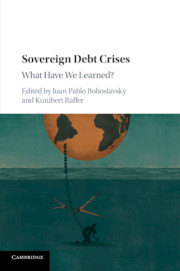Book contents
- Sovereign Debt Crises
- Sovereign Debt Crises
- Copyright page
- Dedication
- Contents
- Contributors
- 1 Introduction
- 2 Managing Public Debt Crisis in Argentina
- 3 Why Developing Countries Should Not Incur Foreign Debt
- 4 Ecuador’s 2008–2009 Debt Restructuring
- 5 Greece: An EU-Inflicted Catastrophe*
- 6 Grenada: A Small Island Developing State Needs New Ways Out of Its Debt
- 7 Iceland: A Human Rights-Sensitive Approach to Deal with Financial Crises
- 8 Indonesia’s 1997–1998 Economic Crisis
- 9 The Irish Sovereign Debt Crisis Post-2009
- 10 Short-Term Capital Controls and Malaysia’s Fast Recovery after the East-Asian Crisis
- 11 Sovereign Debt
- 12 Portugal’s Austerity Bailout
- 13 Don’t Waste a Serious Crisis*
- 14 Lessons from South Korea
- 15 The Spanish Crisis
- 16 Conclusions
- Index
2 - Managing Public Debt Crisis in Argentina
Between Sovereignty and Subordination
Published online by Cambridge University Press: 16 November 2017
- Sovereign Debt Crises
- Sovereign Debt Crises
- Copyright page
- Dedication
- Contents
- Contributors
- 1 Introduction
- 2 Managing Public Debt Crisis in Argentina
- 3 Why Developing Countries Should Not Incur Foreign Debt
- 4 Ecuador’s 2008–2009 Debt Restructuring
- 5 Greece: An EU-Inflicted Catastrophe*
- 6 Grenada: A Small Island Developing State Needs New Ways Out of Its Debt
- 7 Iceland: A Human Rights-Sensitive Approach to Deal with Financial Crises
- 8 Indonesia’s 1997–1998 Economic Crisis
- 9 The Irish Sovereign Debt Crisis Post-2009
- 10 Short-Term Capital Controls and Malaysia’s Fast Recovery after the East-Asian Crisis
- 11 Sovereign Debt
- 12 Portugal’s Austerity Bailout
- 13 Don’t Waste a Serious Crisis*
- 14 Lessons from South Korea
- 15 The Spanish Crisis
- 16 Conclusions
- Index
Summary
Argentina has endured sovereign debt crises practically since its existence as an independent country in the early nineteenth century. This chapter concentrates on the sovereign debt problems related to the period of financial globalization that started in the mid-1970s. The country experienced two debt cycles (1977–80 and 1990–2000) in which a rapid rise of external debt was followed by severe crises (1980–82 and 2001–02). The chapter traces the factors that led to public over-indebtedness, including domestic financial liberalization, macroeconomic policies and the bailing out of private indebted agents. It also describes the economic consequences resulting from debt crises and the very different ways in which these crises were managed, first between 1983 and 1989, and then after 2003. The different approaches in handling sovereign debt crises and their consequences strongly influenced the economic performances and the social and political processes. In one case the government accepted the ‘strategy for the debt’ set by the main creditors, which was consistent with the Washington Consensus policy agenda. In the second case, the management of the sovereign debt problem was consistent with the national priorities and development options. The chapter examines how Argentina managed to restructure its sovereign debt in the latter period, in a way that restored its sustainability, but also the obstacles posed by vulture funds and the ruling of foreign justice courts. It finally extracts some lessons from the Argentinean experience and shows how it has contributed to the international process aimed at establishing a mechanism for restructuring sovereign debts.
- Type
- Chapter
- Information
- Sovereign Debt CrisesWhat Have We Learned?, pp. 12 - 30Publisher: Cambridge University PressPrint publication year: 2017



